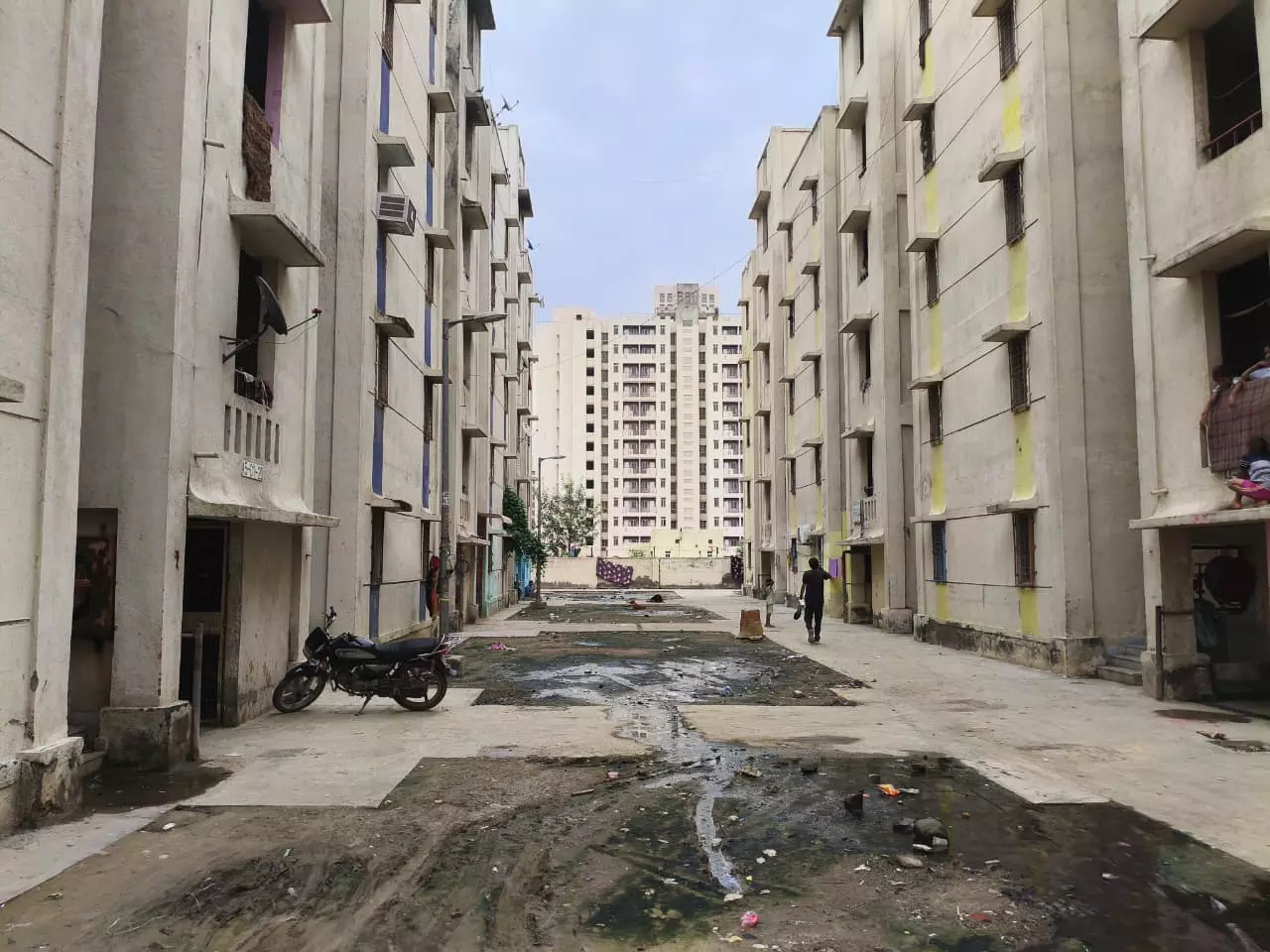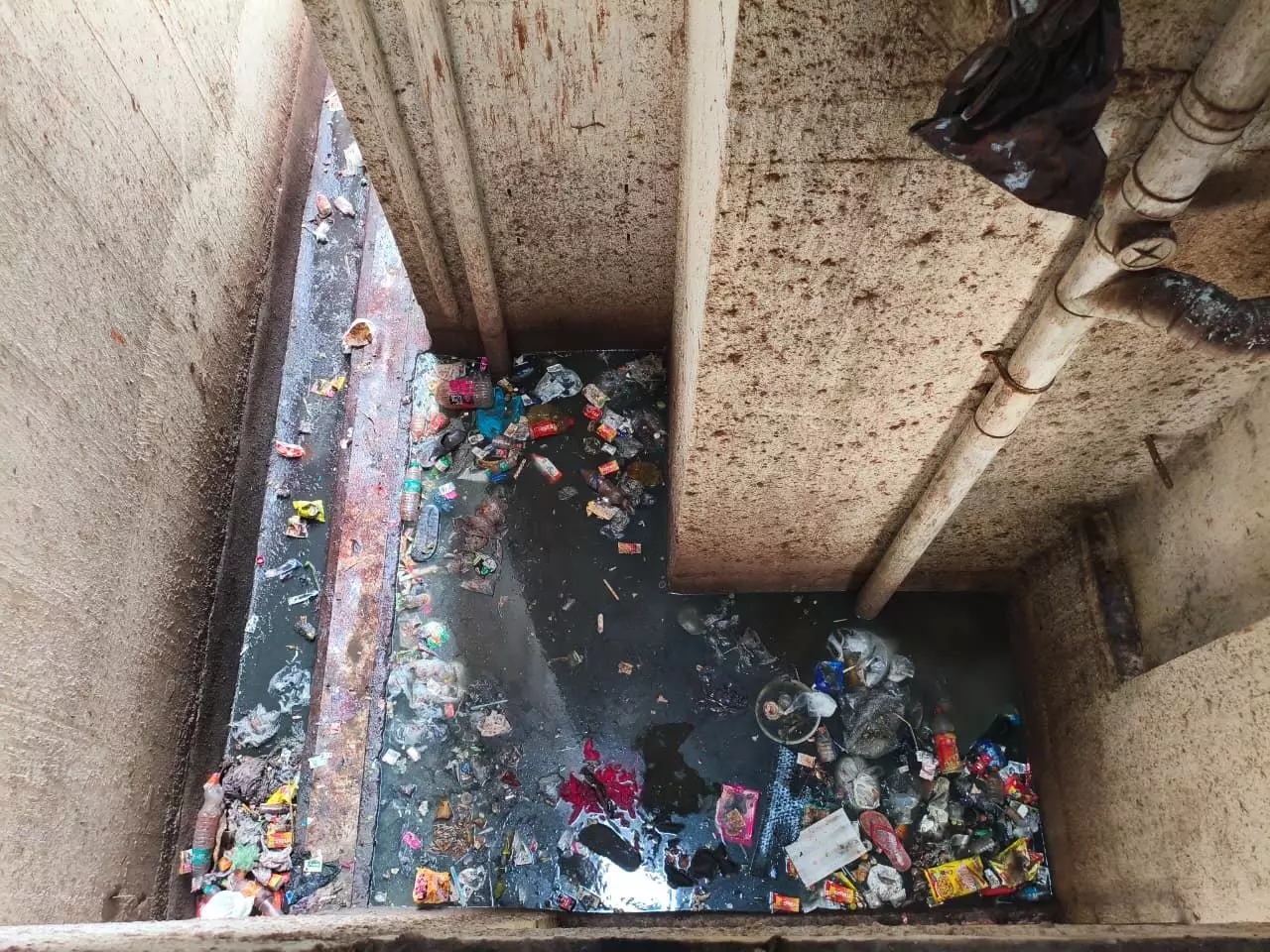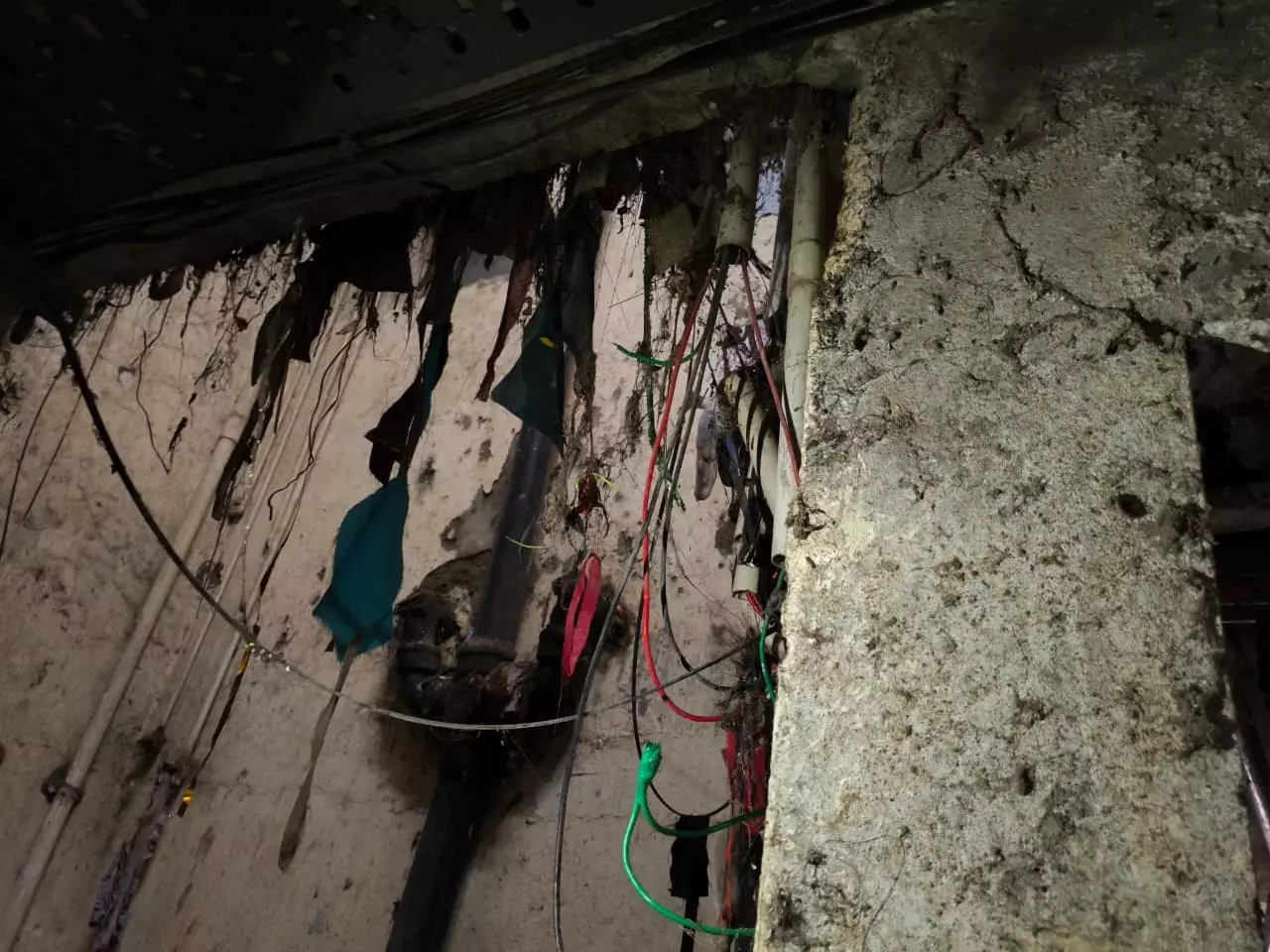
- Home
- India
- World
- Premium
- THE FEDERAL SPECIAL
- Analysis
- States
- Perspective
- Videos
- Sports
- Education
- Entertainment
- Elections
- Features
- Health
- Business
- Series
- In memoriam: Sheikh Mujibur Rahman
- Bishnoi's Men
- NEET TANGLE
- Economy Series
- Earth Day
- Kashmir’s Frozen Turbulence
- India@75
- The legend of Ramjanmabhoomi
- Liberalisation@30
- How to tame a dragon
- Celebrating biodiversity
- Farm Matters
- 50 days of solitude
- Bringing Migrants Home
- Budget 2020
- Jharkhand Votes
- The Federal Investigates
- The Federal Impact
- Vanishing Sand
- Gandhi @ 150
- Andhra Today
- Field report
- Operation Gulmarg
- Pandemic @1 Mn in India
- The Federal Year-End
- The Zero Year
- Science
- Brand studio
- Newsletter
- Elections 2024
- Events
How DDA’s slum rehabilitation flats failed the poor, displaced families in Delhi
Over 5,000 homes were razed in three years, the latest being Tamil migrants at Madrasi Camp, but poor infrastructure and lost livelihoods are forcing many to return to rented rooms near their old bastis

On a sweltering August afternoon, Ulaganathan sits before the loud hum of his desert cooler in his one-BHK (bedroom, hall, kitchen) apartment in Delhi. Carefully, he unties a bulky cloth bundle. There’s a metallic clatter, and more than 40 keys tumble onto his tiled floor, each tagged with a sellotaped sticky note bearing a flat number. They’re identifiers of homes and their owners...
On a sweltering August afternoon, Ulaganathan sits before the loud hum of his desert cooler in his one-BHK (bedroom, hall, kitchen) apartment in Delhi. Carefully, he unties a bulky cloth bundle. There’s a metallic clatter, and more than 40 keys tumble onto his tiled floor, each tagged with a sellotaped sticky note bearing a flat number. They’re identifiers of homes and their owners who no longer live here, or never did.
It was in June this year that 370 shanties in the Madrasi Camp — inhabited by Tamil migrants — near Jangpura were demolished on the instructions of the Delhi High Court, to clear the nearby Barapullah drain. Out of these, around 215 families found rehabilitation in a Delhi Development Authority (DDA) colony in Narela’s Pocket 4 and 5. The rest were found ineligible. Yet, more than two months down the line, there are not more than five families staying in Narela, says Ulaganathan, who is in his 30s. Their worst fears having been proven right, most have decided to take homes on rent near their old camp, even if it pinches their pockets.
“Since the time we were allotted the flats, there have been multiple robberies here. Expensive electrical wires have been cut and taken, sometimes even during the day. We suspect insiders are involved. Some families did not shift because their livelihood would have been impacted. Those who did have also left after a spate of burglaries. All of them have given me the keys now and told me to keep them safe. No one wants to live here,” he says, his voice thick with resignation.
Krishna Murthy, a resident of the Madrasi Camp who got accommodation at Narela, was one among many whose houses were allegedly robbed, even before full occupancy. An almirah and two ceiling fans vanished, along with the electrical wires. “I work as a cleaner at the Rashtrapati Bhavan and have to report at 7 AM. How would it be possible for me to travel from Narela every day? That’s why I decided to live on rent at Ashram. I earn Rs 18,000 a month and pay Rs 9,000 rent here. It’s difficult, but it’s still preferable to travelling from so far away,” says Murthy, who is in his 40s.
Unlike many others from his camp, Veerappan Kumar, who drives a rickshaw, shifted to Narela initially, hoping that a pucca flat would make life better for his family. Yet within days, he, too, became the victim of an alleged robbery. And that was not all. “We were on the ground floor, and sewage water kept flooding our home. We were told there would be a bus service from Narela to the Delhi Tamil Education Association (DTEA) School in Lodhi Estate, where most of the children from our camp study. But nothing happened. This is not the life we had dreamed of or were promised. I decided to move back and rent a house at Ashram. My son is in class 10. Until he finishes his education, we will stay here. I will do whatever it takes to educate him. I am a rickshaw driver, but my son will not be one,” says Kumar, in his mid-forties.
Also read: How Bengaluru’s garbage is ruining lives of villagers in Karnataka’s Doddaballapur
This is not the case in one rehabilitation colony. For many slum dwellers across Delhi, the state government’s promise of a pucca flat and a better life has stayed just that — an empty promise. During the monsoon session of Parliament, on July 22, Union Minister of State for Housing and Urban Affairs Tokhan Sahu told the Rajya Sabha that in the last three years, the DDA had demolished 5,185 houses, of which only 3,043 households had been rehabilitated. The slum dwellers were given in-situ rehabilitation in three locations — Ashok Vihar, Kalkaji Extension and Narela.

Sewage water inside the DDA complex at Narela, Pocket 4
The Federal visited all three DDA flat complexes and found the same grim picture, though in varying degrees — waterlogged lanes, open drains, overflowing sewage, exposed electrical wires, and unsafe structures. Inside, the flats appeared polished, with tiled floors and fresh paint, but the buildings themselves were riddled with seepage and showed worrying signs of structural weakness.
In January, Prime Minister Narendra Modi inaugurated the Swabhiman Apartments in Ashok Vihar amid much fanfare. Yet, swabhiman (self-respect) is a thing that several who live here feel has been snatched from them. A nearly 400-metre stretch of road leading up to the apartments is strewn with garbage on both sides, and a huge puddle of sewage water lies just opposite the entrance to the colony.
Four months after shifting to her first-floor flat, Geeta Devi says sewage lines remain the biggest issue in the flats. “There are no exhaust fans in our kitchen, people throw their waste from the windows, and it stinks up the whole locality. There is sewage water everywhere; there is no proper drainage system. Nobody cares about cleanliness,” she says.
When she used to stay in the Rampura slum, Geeta, who is her 40s, would earn Rs 4,000-5,000 a month from packing stationery boxes. Here, she has no work and is entirely dependent on the income of her husband, a driver. “That money was not enough to run the house, but it gave me a sense of purpose and some self-worth. I don’t have that anymore,” she says.
For several other residents, the quality of water is the biggest issue. Harpal Singh, a painter and erstwhile resident of a slum in Jailorwala Bagh, said the water quality is so bad that residents have to call for tankers privately. “It is undrinkable. Even with the RO, it is a problem,” he says. Dinesh, a courier, says he developed rashes on his thighs because of bathing with the supplied water. “I am not the only one; there are several people who are developing skin infections,” he says.

Garbage and sewage at the Swabhiman Apartments, Ashok Vihar, which was inaugurated by PM Narendra amid much fanfare. Swabhiman (self-respect) is a thing that several who live here feel has been snatched from them.
Yet some say the upkeep of the apartments is not just the duty of the DDA, but also the residents — a task they’re failing at. “Ultimately, we have to keep our surroundings clean. Most people here throw the trash anywhere, pee inside the elevators and spit and drink in the open. How much can someone clean?” says a security guard at the Swabhiman Apartments, who did not wish to be named.
At the Asha Kiran Apartments in Kalkaji Extension, the reaction is more mixed. The older residents have adjusted to the flats — warts and all — but for those who moved here from the nearby Bhoomiheen Camp just a few months ago, life has been difficult.
Here too, The Federal found exposed electrical wires near seepage-ridden walls, inoperative lifts, unsafe structures and reports of stolen earthing wires. Seema Saxena, a nurse who is now unemployed and a single mother, reports that new earthing wire was stolen shortly after her allotment around two months ago. “The drainage system here is also very poor. We are on the 13th floor, and one of the lifts remains constantly inoperative. The water tank lids are left open, which keeps contaminating our water. If you need to get any work done, you have to call someone privately and pay. I have not even found work after shifting here. As of now, we are facing several problems,” she says.
Another resident, who did not wish to be named, says he shifted here around a month ago, as his flat was caught in a dispute. In his home, The Federal found windows without panes. “It has been raining non-stop, and our house has been getting flooded. We have told the RWA, but nothing has happened so far. Earthing wire worth Rs 7,500 was also stolen, which is a huge amount for people like us. There are also structural and seepage issues,” he says.
Also read: How climate change, tourism, and human greed push Uttarkashi towards disaster
“However, there are some benefits, too. We have an RO system, and water is available 24x7. There is also some privacy here since it’s a 1 BHK, not the one-room setup we had in the slum. But time will tell if this turns out to be what was promised to us,” he says.
These demolitions have also ignited political backlash. From the Aam Aadmi Party, to the Congress, to Left parties like CPI(M) and CPI(ML) Liberation, everyone has held demonstrations and hit out at the ruling BJP for denying homes to the vulnerable and betraying the promise of ‘jahan jhuggi, wahan makaan (A house wherever there is slum)’.

Naked electricity wires hanging on seepage-ridden walls at Asha Kiran Apartments, the in-situ rehabilitation at Kalkaji Extension.
Facing fire, Delhi Chief Minister Rekha Gupta on August 1 said that demolitions would be halted in the city, and that the state government would be open to amending its slum policy. However, this was not the first time she made the statement. In June, too, the Chief Minister had said no slums would be demolished illegally.
Despite these assurances, thousands remain in limbo, as the disparity between policy announcements and on-the-ground conditions remains in doubt. The Federal reached out to DDA PRO Bijay Shankar Patel, but he did not respond to queries.
Back in his Narela flat, Ulaganathan is getting ready to pack up and leave, along with his wife, two children and niece. “After Independence Day, I will also move out. When I came here, I had Rs 50,000 as savings. Now, I have only Rs 12,000 left. I have not found work. Most importantly, my son has not gone to school for two months. He has only ever studied at DTEA; he doesn’t even know Hindi. If I send him to a school here, his life will be miserable. He won’t understand a thing, and other children will make fun of him,” he says.
“We have got a good flat. There is water, electricity, and tiling, even though there are other issues. But without our livelihoods and our children’s education, what will we do with these beautified structures?” he says.
For Ulaganathan, Geeta, Veerappan and Seema, the new flats may present the façade of upward mobility, but without basic services or a means to earn a living, they are little more than hollow shelters.
